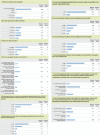Practice patterns regarding noninvasive rhinosinusitis in the immunosuppressed patient population
- PMID: 24498520
- PMCID: PMC3911804
- DOI: 10.2500/ar.2013.4.0070
Practice patterns regarding noninvasive rhinosinusitis in the immunosuppressed patient population
Abstract
The number of immunosuppressed patients is growing remarkably. Currently, there is no guideline on how treatment of noninvasive sinusitis in these patients may differ from that of the general population, and practice patterns vary widely across the country. The purpose of this survey was to examine practice patterns and management for this patient population. A survey and literature review were performed. The survey was sent to the membership list serve of the American Rhinologic Society. Twelve questions were asked. Four demographic questions were asked about the physicians and their practices. Four questions were asked about the type of immunocompromised patients they saw. Two questions were asked about management in the setting of significant acute and chronic sinusitis. The responses were collected and analyzed using Pearson independent chi-square testing. Of 871 members on the list serve only 89 physicians responded. The majority of responders were sinus and skull base surgeons practicing in an academic setting. There was a large range of geographic location, years in practice, and patient population. Two significant findings related years in practice to management of chronic sinus immunocompromised patients (p = 0.012) and correlated the choice of management option in acute and chronic sinus immunocompromised patients (p = 0.006). There is no standardized method of treating the vulnerable patient population of immunocompromised patients with noninvasive acute and chronic sinusitis and this survey shows the wide range of practice. Clinical research is needed to standardize and optimize treatment for these patients.
Keywords: Acute; chronic; immunocompromised; immunodeficiency; immunosuppressed; management; medical therapy; rhinosinusitis; sinusitis; surgical therapy; treatment.
Conflict of interest statement
The authors have no conflicts of interest to declare pertaining to this article
Figures
References
-
- Fried MP, Kelly JH, Strome M. Pseudomonas rhinosinusitis. Laryngoscope 94:192–196, 1984 - PubMed
-
- O'Donnell JG, Sorbello AF, Condoluci DV, Barnish MJ. Sinusitis due to Pseudomonas aeruginosa in patients with human immunodeficiency virus infection. Clin Infect Dis 16:404–406, 1993 - PubMed
-
- Milgrim LM, Rubin JS, Rosenstreich DL, Small CB. Sinusitis in human immunodeficiency virus infection: Typical and atypical organisms. J Otolaryngol 23:450–453, 1994 - PubMed
-
- Marks SC, Upadhyay S, Crane L. Cytomegalovirus sinusitis. A new manifestation of AIDS. Arch Otolaryngol Head Neck Surg 122:789–791, 1996 - PubMed
-
- Rombaux P, Bertrand B, Eloy P. Sinusitis in the immunocompromised host. Acta Otorhinolaryngol Belg 51:305–313, 1997 - PubMed
LinkOut - more resources
Full Text Sources
Other Literature Sources



